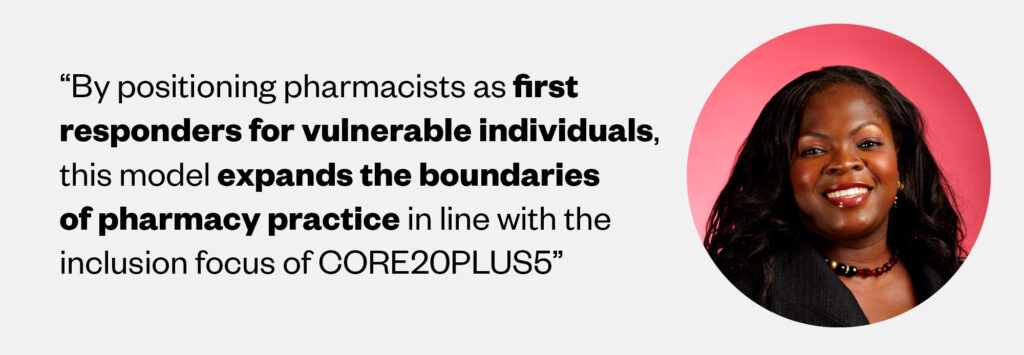
In the previous science and research blog, I introduced the concept of ‘Core20PLUS5’, a national NHS England approach to “inform action to reduce healthcare inequalities at both national and system level”. I also highlighted how pharmacy practice can support the mission to tackle healthcare inequalities related to clinical conditions. In this blog, I focus on reviewing recent papers, published in the International Journal of Pharmacy Practice, that show how pharmacy practice can support the mission to tackle healthcare inequalities related to wider social, systemic and structural issues, thus furthering the aims of Core20PLUS5.
Inclusion and structural inequality
The ‘PLUS’ in Core20PLUS5 includes groups who experience multiple layers of disadvantage. This is where pharmacy’s role in inclusion health becomes particularly important.
A qualitative study on racial minority stressors1 in pharmacy education and practice revealed persistent experiences of discrimination, tokenism and microaggressions among minoritised pharmacy professionals. These stressors influence not only wellbeing and retention, but also the ability to deliver culturally competent care. Similar findings were highlighted in another study with fewer participants, which highlighted that discrimination continues to persist in community pharmacy, especially related to race, with recommendations that accessible and culturally responsible resources, such as discrimination reporting mechanisms, were necessary. Another study on transgender healthcare2 found that Australian pharmacists lacked confidence, training and, sometimes, willingness to engage meaningfully with trans and gender-diverse people. Participants called for urgent reforms in pharmacy education and regulation to support inclusive practice.
These findings echo broader NHS concerns around structural racism and health disparities. They reinforce the need for pharmacy to reflect on its own institutional culture as part of delivering equitable care.
Digital exclusion and the role of pharmacy
The NHS’s increasing reliance on digital-first services risks entrenching health inequalities unless mitigated by inclusive strategies. A study examined who is most at risk of digital exclusion in healthcare3 and found that older adults, people on low incomes and those with lower literacy are particularly affected.

This digital divide is not merely a technological challenge but a social determinant of health. Pharmacy teams — particularly in community settings — are well positioned to act as digital inclusion enablers, supporting patients to access, understand and benefit from digital health interventions. The NHS has issued a digital inclusion framework, highlighting the role of digital inclusion hubs by providing “patients and carers with digital access and skills support to use online GP and NHS services.”
Social health and sustainability
The Lifeguard Pharmacy project4 exemplifies how pharmacies can innovate to meet complex, unmet social needs. This initiative co-developed a community pharmacy-based response for people experiencing domestic abuse or suicidal ideation, leveraging the accessibility and trust associated with pharmacies. By positioning pharmacists as first responders for vulnerable individuals, this model expands the boundaries of pharmacy practice in line with the inclusion focus of Core20PLUS5.
Finally, the introduction of a national tool to monitor inhaler carbon footprints5 intersects with both climate and health equity agendas. While promoting greener prescribing is essential, it must be implemented in ways that do not exacerbate access issues or overlook patient capability, particularly for those with physical or cognitive impairments (Maree et al., 2024). The RPS greener pharmacy guides and toolkit are available to “help pharmacy staff reduce their carbon footprint”.
Evidence-based insight
These papers provide evidence-based insight into how pharmacists are adapting to meet the needs of under-served populations. They provide examples of published evidence of pharmacy teams as important contributors to the mission of health equity in healthcare — but they also show that realising this potential requires strategic investment in education, inclusive leadership and sustained policy support6.
Pharmacy teams worldwide have a vital role in tackling healthcare inequalities. In the UK, prioritising populations and clinical conditions identified across the adult and paediatric Core20PLUS5 frameworks is an important approach.
- 1.Ahmed A, Hagos M, Bhatti I, et al. A qualitative study exploring experiences of racial minority stressors in pharmacy education and practice. International Journal of Pharmacy Practice. 2024;32(Supplement_1):i9-i10. doi:10.1093/ijpp/riae013.012
- 2.Chaudhary S, Lindsay D, Ray R, Glass BD. Do the attitudes and practices of Australian pharmacists reflect a need for education and training to provide care for people who are transgender? International Journal of Pharmacy Practice. 2023;32(1):61-68. doi:10.1093/ijpp/riad077
- 3.Wilson S, Tolley C, McArdle R, Slight R, Slight S. Who is most at risk of digital exclusion within healthcare? International Journal of Pharmacy Practice. 2024;32(Supplement_1):i3-i4. doi:10.1093/ijpp/riae013.004
- 4.Barcelos AM, Latham-Green T, Barnes R, et al. Lifeguard Pharmacy: the co-development of a new community pharmacy response service for people in danger from domestic abuse or suicidal ideation. International Journal of Pharmacy Practice. 2024;32(6):452-460. doi:10.1093/ijpp/riae043
- 5.Boldero R, Griffiths S, Coulson J. Introducing a new national tool to monitor the carbon footprint of inhalers. International Journal of Pharmacy Practice. 2024;32(Supplement_1):i26-i27. doi:10.1093/ijpp/riae013.033
- 6.Ashiru-Oredope D, Osman R, Ayeni AH, et al. Pharmaceutical Public Health: A Mixed-Methods Study Exploring Pharmacy Professionals’ Advanced Roles in Public Health, Including the Barriers and Enablers. Pharmacy. 2025;13(2):37. doi:10.3390/pharmacy13020037


